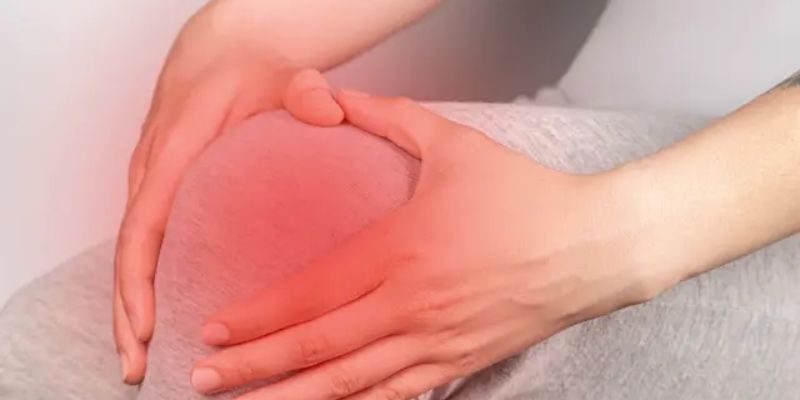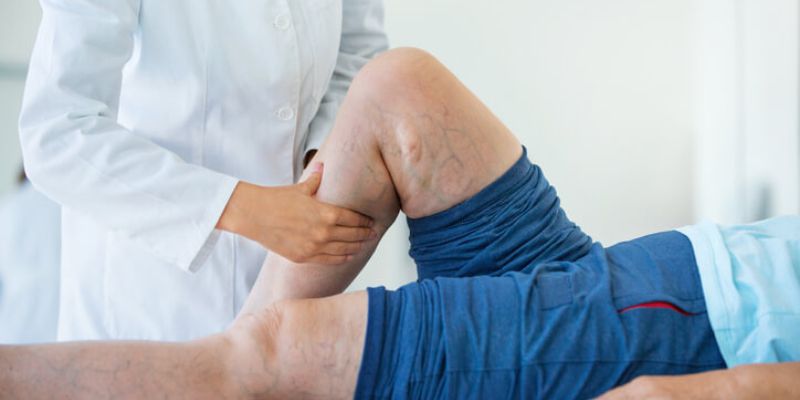If you've ever woken up with swelling and fluid on your knee, you know the discomfort can quickly become unbearable. Struggling to walk or even stand without pain is not an ideal start to a day - luckily, several treatments are available for fluid on the knee.
We'll look at what causes it, how to identify it, and some evidence-backed techniques for getting rid of that pesky joint inflammation so you can get back to living life pain-free.
What is Fluid On The Knee

Fluid on the knee, also known as effusion or "water on the knee," is an accumulation of excess fluid in the joint space between your bones and cartilage. It's usually caused by inflammation and typically appears swollen, with tenderness, stiffness, and a restricted range of motion around the affected area.
What Causes Fluid On The Knee

Common causes of fluid build-up on the knee include:
- Injuries
- Underlying inflammatory conditions, such as arthritis
- Cysts (fluid-filled sacs under the skin)
- Infections
Injuries
Injuries to the knee joint, such as a sprained ligament or torn meniscus, can cause inflammation and fluid accumulation. Additionally, activities that require repetitive movements of the knee joints (such as running or jumping) can put extra strain on your knees and increase the risk of developing fluid.
Inflammatory Conditions
Joint inflammation, such as that caused by arthritis or gout, can cause fluid to accumulate in the knee. In some cases, the underlying condition can be treated with medications and lifestyle changes - if you suspect inflammatory conditions are causing your knee pain, it's best to talk to your doctor about treatment options.
Cysts
Cysts are fluid-filled sacs that can develop under the skin around your knee joint. They are usually harmless but can cause discomfort and inflammation. If you have a cyst, it is important to seek medical attention so your doctor can determine the right treatment plan for you.
Infections
An infection can sometimes cause fluid on the knee. This fluid accumulation is usually accompanied by fever, redness, and warmth around the infected joint. Your doctor can diagnose an infection based on a physical exam or lab tests and prescribe the necessary antibiotics to clear up the infection.
How To Identify Fluids On The Knee
The most common symptom of fluid on the knee is swelling. This may be accompanied by pain, tenderness, and a restricted range of motion around the affected area. To diagnose fluid on the knee, your doctor will typically perform a physical exam and order imaging tests such as X-rays or an MRI to see if there is any structural damage to the joint.
Treatments For Fluid On The Knee
There are several treatments available for fluid on the knee depending on its cause:
Rest and Immobilization
Taking a break from activities that put extra stress on your knees is usually recommended as part of an effective treatment plan. Depending on the severity, your doctor may also recommend immobilizing the knee with a brace or cast.
Cold Compress
Inflammation and swelling can be reduced by applying a cold compress, such as an ice pack, to the affected area for 15 to 20 minutes. To avoid hurting your skin, wrap the ice in a towel.
Nonsteroidal Anti-inflammatory Drugs (NSAIDs)
These medications are commonly prescribed to reduce swelling and pain. Talk to your doctor before taking any NSAIDs and follow their directions for safe use.
Corticosteroid Injections
Corticosteroids, such as cortisone or methylprednisolone, can be injected directly into the knee joint. This can provide immediate relief from symptoms and inflammation.
Physical Therapy
Physical therapy is often prescribed to improve the strength and flexibility of muscles around the knee joint. Strengthening exercises, stretching, and balance training can help reduce pain and fluid buildup in the joint.
Surgery
Surgery may be necessary to remove excess fluid or damaged tissue in the knee joint. Your doctor will review your medical history and imaging results to determine whether surgery is a good option.
Weight Loss
If you are overweight, losing weight can help reduce stress on your joints by taking some pressure off them. Talk to your doctor about healthy eating habits and an exercise plan.
Diet
Inflammation and swelling in the knee joint can be reduced with the aid of an anti-inflammatory diet. Salmon, flaxseeds, walnuts, and chia seeds are foods rich in omega-3 fatty acids that can help with inflammation and pain management. Keeping away from processed foods, sugar, dairy, and gluten may help to lessen edoema.
Supplements
Supplements such as glucosamine and chondroitin can be taken to improve joint health and reduce inflammation. Talk to your doctor before taking supplements and follow their directions for safe use.
Alternative Treatments
Alternative treatments such as acupuncture, massage therapy, and yoga can also help reduce inflammation and pain. Talk to your doctor before trying alternative treatments, as they may not be safe for everyone.
Home Remedies
Home remedies such as apple cider vinegar and Epsom salt baths can help reduce swelling. Apple cider vinegar reduces inflammation and has antiseptic properties that may help fight infection. Epsom salt baths can draw out excess fluid from the joint.
Natural Ointments
All-natural ointments such as arnica gel, menthol, and capsaicin cream can also help reduce inflammation. These topical treatments should be applied directly to the affected area for relief.
No matter the cause of your fluid on the knee, it's important to seek medical attention to determine the best treatment plan for you. You can get back to living pain-free with proper care and treatment. Additionally, maintaining a healthy lifestyle with regular exercise and a balanced diet can help reduce your risk of developing fluid in the knee.
With proper diagnosis and treatment, you can relieve pain and stiffness due to fluid in the knee. Exercise is an important part of any treatment plan for short-term relief and long-term prevention.
Regular physical activity can help improve knee strength and flexibility, reduce inflammation in the joint, and prevent future injury. Taking steps to maintain a healthy weight can also help reduce stress on the knees and help prevent fluid build-up.
By following your doctor's instructions and making lifestyle changes, you can find long-lasting relief from fluid on the knee.
FAQS
Is walking good for fluid on the knee?
Yes, walking is a great option for people with fluid on the knee. Walking can help improve joint mobility and reduce inflammation in the affected area. It is important to talk to your doctor before starting any new exercise regimen and follow their instructions for safe use.
What foods help fluid in the knee?
Foods high in omega-3 fatty acids, like salmon, flaxseeds, walnuts, and chia seeds, can help reduce inflammation and pain. Additionally, an anti-inflammatory diet low in processed foods, sugar, dairy products, and gluten may also be beneficial for reducing swelling.
How long does it take to reduce fluid in the knee?
The amount of time it takes to reduce fluid in the knee depends on the cause and severity of your condition. Treatment options such as rest, cold compresses, NSAIDs, corticosteroid injections, physical therapy, or surgery may be necessary to find relief. Talk to your doctor to determine the best treatment plan for you.
Conclusion
While fluid on the knee can be uncomfortable, many treatments and preventive strategies can help. Building stronger muscles around your joints is a great way to prevent long-term issues and eliminate existing problems. Additionally, compression garments, elevation of your leg, and other physical therapies have proven successful in treating knee pain, swelling, and discomfort. Depending on your condition, you can contact a medical professional to get individualized treatment specific to your needs. Remember, fluid on the knee cannot always be avoided, but it can be managed.

Benefits of Gooseberries
Apr 25, 2023

Common Causes of Inner Knee Pain
Apr 24, 2023

What is Neuralgia
Apr 20, 2023

Home and Natural Remedies for Toothache Pain
Apr 19, 2023

What is a Gastroenterologist
Apr 18, 2023

What Is a Zero-Carb Diet
Apr 25, 2023

Benefits Of Cucumber
Apr 24, 2023

Benefits of Hawthorn Berry
Apr 20, 2023



